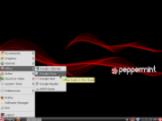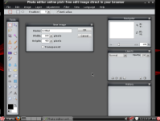Peppermint OS: Another member of "Team Linux"
The first question that springs to mind when hearing of a new Linux distribution is not "what does it do?" but "why?" It would seem by now that virtually every possible angle has been covered, and that a Linux distribution must exist for almost any use case one could conceive of. Yet the recently-announced Peppermint Linux is slightly different in that it seeks to bridge the gap between standard desktop computing and "cloud" computing.
Peppermint is a fourth-generation Linux distribution. Peppermint is based on Linux Mint, which is in turn based on Ubuntu, which is based on Debian. It uses the LXDE desktop and Mozilla Prism, Mozilla's Firefox-based site specific browser, to run web-based applications more like standard applications. Aside from a different set of default applications, slight customization of Prism, and some pepperminty artwork, there's not a great deal of difference between Peppermint and Linux Mint's LXDE and Fluxbox editions. That's not surprising, Peppermint Linux contributor Kendall Weaver also contributes to Linux Mint and Lubuntu. Shane Remington is responsible for the web development and marketing for Peppermint, and Nick Canupp handles the forums and bug tracking.

One of Peppermint's most distinguishing features may be the attention paid to marketing. It's unusual for a fledgling distribution to focus intently on marketing, but Remington feels that a lack of marketing is one of the reasons that Linux has not won more converts.
Given that Weaver is already contributing to other distributions, why would another distribution be necessary?
Originally the concept was rather simple, we were going to take Linux Mint and make it "spicier" (hence, the name "Peppermint") by adding clean social network integration. I love the look of Sidux so we decided on a color scheme in that general neighborhood. I guess the single biggest inspiration is the fact that with more applications moving to the cloud, your OS serves less purpose as an OS and more of a portal. We decided that we wanted to build the best portal.
[...] You can have a super fast, lightweight, desktop - make it your own with whatever you want to install yet have the ability to fire off a web application in Prism which allows the SaaS [Software as a Service] or PaaS [Platform as a Service] to act as if it's installed locally.
To be clear, though, Weaver and Remington stressed that Peppermint is not about competing with other Linux distributions. Instead, they say they're part of "Team Linux." Remington says a main objective behind Peppermint is "to gain new users for Team Linux
":
Peppermint installs easily and works out of the box. You don't need, and shouldn't need, any type of super-geek hacking skills to operate a Linux system and we set out to prove that one point. There hasn't been one person we've sat Peppermint in front of who [couldn't] pick up the mouse and figure it out almost instantly. That was our goal and we feel pretty strongly that we achieved it.
According to Weaver, the Linux desktop-only or cloud-only offerings made no sense. Peppermint OS was envisioned as a "hybrid desktop
" that bring the two together and give "the user more freedom and more choices while offering a comfortable and familiar computing experience
". Instead of taking the plunge directly from something like Ubuntu directly to ChromeOS, Weaver says that Peppermint is about "exposing a lot of the possibilities of what can be done in the cloud without taking away the ability to easily install local applications to handle all of the same functions
".
No doubt this concept would not thrill Richard Stallman. Much of the software that Peppermint OS points to is free as in beer, but not free as in freedom. For example, Peppermint points to Google Docs for users who want to edit office documents and Pixlr for photo editing. Users wanting offline applications will need to install the standard Linux applications, since offline support is not available for the included web applications. Presumably this will change as Google and other providers introduce offline features based on HTML5, but for the time being there's not much support for offline use of web apps.

The social network integration that Weaver mentioned is minimal. Peppermint includes a Facebook link in the application menu, but beyond that there's not much integration so far. Ubuntu 10.04 goes much farther with the "Me Menu" and the selection of Gwibber to connect to Facebook, Twitter, Identi.ca, Flickr and others.
As its heritage suggests, there's not a great deal of difference between Peppermint and others in the Ubuntu/Mint family. Users who are looking for a light desktop with a lot of integration with web-based services can try Peppermint or just use Lubuntu or Linux Mint's LXDE release and install the Prism package. There doesn't seem to be a lot of "special sauce" in Peppermint, at least the current iteration, that isn't available in other distributions. Whether it takes off with Windows and Mac users is another story. According to Remington, appealing to Windows and Mac users isn't something "Team Linux" has done well thus far, but they hope to address that with Peppermint.
The Peppermint project doesn't have a strong commercial push yet, but Remington did hint that "there are some things on the table that we are working on but we are keeping a tight lid on for the moment
". Peppermint will have a 64-bit version "soon
" and "another special something that we will announce here in a few days' time, we hope
".
As it is, Peppermint really doesn't have much to offer above and beyond current distributions for existing Linux users. It remains to be seen what the team does from here, but it's hard to see why the same work couldn't have been accomplished under the umbrella of another project. A custom edition of Lubuntu or Linux Mint, within the frameworks of those projects, would probably be more effective. Any marketing push and web development that Remington could supply to gain attention with Windows and Mac users for Peppermint could as easily be applied to an existing project. Perhaps Peppermint will evolve into something unique and compelling over time, but so far it's hard to see the reason for yet another entirely new Linux distribution.
| Index entries for this article | |
|---|---|
| GuestArticles | Brockmeier, Joe |
Posted Jun 3, 2010 9:39 UTC (Thu)
by AndreE (guest, #60148)
[Link]
Ok they're not saying that exactly, but let's be honest, marketing is the thing that will come AFTER desktop linux is actually ready for a direct confrontation with windows and osx.
Peppermint OS: Another member of "Team Linux"

